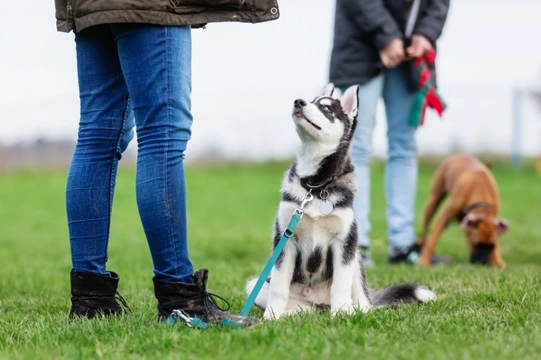
How do socially distanced dog training classes work in practice, and are they effective?
Can you still attend dog training classes given Covoid-19 restrictions? This will depend on what tier your local area is in and the restrictions you are subject to, as well as whether or not dog training class providers are able to hold classes while managing social distancing and safe practice.
Generally, other than when it is a physical impossibility or local rules forbid it, socially distanced dog training is going on all over the UK. But how does socially distanced dog training work in practice, and is it as effective as regular dog training? Are socially distanced dog training classes worthwhile?
Read on to find out how socially distanced dog training works; and if it actually works at all!
Where are socially distanced dog training classes held?
One of the biggest changes to dog training classes in the era of Covid 19 is that they’re generally being held outdoors only, even by training providers that previously operated from indoor spaces.
This helps to reduce the spread of Covid 19 and reduce the exposure of different dog owners to each other.
Avoiding gatherings at the start and end of sessions
Much like when people drop their kids off at school and pick them up again (in normal times!) the gates or entrance to dog training classes tend to see the parents or owners respectively gathering and chatting at the start and end of the session.
This is obviously something that should be avoided given the risks of Covid transmission, and so generally dog owners are asked to come only at the appointed start time and not earlier, and wait in or by their cars until called into the class.
Generally each dog and owner will be pointed to a designated space, and brought in and out one by one in turn to keep everyone apart.
Managing the space to keep individual dog owners apart
When the class enters and gets underway, dogs and owners will be allocated to their own marker or area, and asked to stay within its boundaries for the duration of the class unless instructed otherwise. This too will help to keep the various different dog owners physically apart from each other.
Avoiding shared kit and props
Equipment is often involved in dog training classes, usually provided by the class trainer and shared between the participants. However, both to avoid close contact between owners when picking up and returning kit used in classes and to prevent Covid being spread on the kit itself, this generally won’t be the case in socially distanced classes.
This may mean that no equipment is used, that dog owners are asked to bring specific things to use for their own dogs themselves, or that equipment is allocated to each dog owner and set up before the start of each class, sanitised and prepped thoroughly before and after each class to keep participants safe.
Smaller classes across wider spaces
Class sizes for socially distanced dog training will generally be smaller in terms of numbers than at other times too, for a number of reasons. The first of these is of course to ensure that suitable space can be maintained between owners, and the second comes down to the logistics of classes being held out of doors.
When you factor in the added distance between participants, this means that if there were a large number of people present, those further from the trainer would struggle to see and hear them clearly. The added noise outside contributes to this effect too.
One dog, one handler
At training classes in normal times, children are often welcome to come and get their first taste of dog training with their own pet, or couples that have a dog and dogs otherwise in shared ownership are brought by both of the people who will be responsible for their training and management.
However, to support social distancing, the rule will almost always be one handler per dog, and no group outings!
No spectators
Spectators in the form of other people that live with or help with the dog are usually welcomed to see how it all works and to follow what the dog is learning, but this too is something that has largely been suspended in socially distanced dog training classes.
Most such classes will ask you not to bring others with you to watch the class.
Keeping dogs apart
Keeping dog owners apart goes out of the window if two dogs need to be split up or won’t keep away from each other! This means that socially distanced training classes are almost always conducted mainly or wholly with all of the dogs on the lead at all times. This may mean you’re asked to bring an extendable lead with you to emulate off-lead skills as far as possible.
General good hygiene
Dog owners will generally be asked to use sanitizer frequently, and wash their hands as soon as possible before and after the class.
Some classes may ask participants to wear facemasks for all or part of the class, or parts they are not partaking in; although facial expression can be an integral part of training a dog, so this is not generally a blanket rule across all parts of the class.
Are socially distanced dog training classes still effective?
Yes, when handled effectively and with their potential limitations (such as less chances for participating dogs to socialise with each other) taken into account, socially distanced dog training still gives dogs an advantage for owners that benefit from classes in general.
In some ways and for some dogs, they might even prove more effective, as the distance between participants and lower levels of interaction between dogs reduces distractions; however, it is important to bear in mind that things like recall, which needs to be effective off-lead, may be limited by the restrictions of socially distanced dog training classes.



